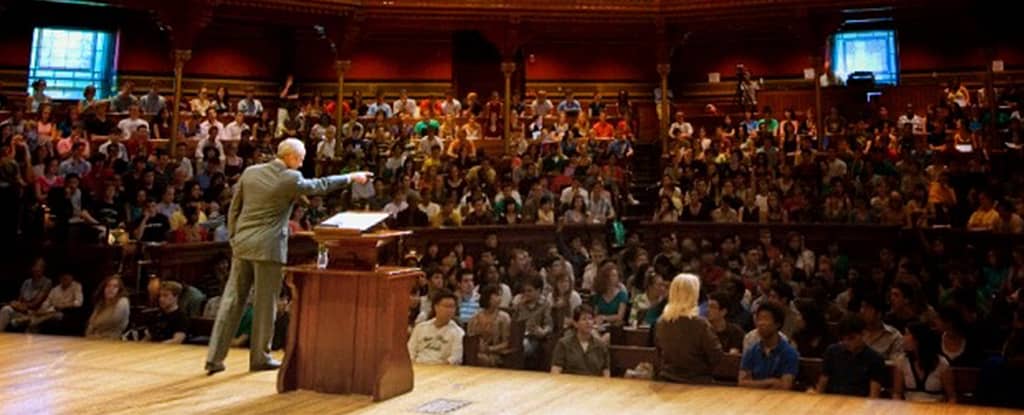
This article on How to Keep Class Sessions from Running Short (Or Going Too Long) was originally posted on the EdSurge website and is reposted here with permission. It is part of the guide Toward Better Teaching: Office Hours With Bonni Stachowiak. You can pose a question for a future column here.
Dear Bonni,
How can I design my class sessions to fit the available time? I never see this discussed in resources for effective teaching, but it has been a big challenge for me for many years. I'm always concerned about having too much or too little material.
With any interactive or active form of learning, so much of how a class goes depends on the students. So it's not like presenting a speech where you are in complete control of the time. Any error causes problems that ripple through the semester, especially when I'm teaching multiple sections that need to stay in sync. And any change in the course coverage or how I construct the classes makes prior years' experience largely irrelevant.
—Kevin Werbach, professor, The Wharton School, University of Pennsylvania
The fears about not having enough material to fill a class, or in getting behind with what you planned, are common. Peter Newbury, director of the Centre for Teaching and Learning at University of British Columbia Okanagan, recalls such a time for him.
“A memorable teaching experience for me was the day I ‘lost control.’ The students were so engaged in discussions, I had no authority. It was awkward. And awesome. In hindsight, I created a safe environment, posed good questions, and gave them agency. I prepared to do nothing.”
Below are five approaches to use regarding the time-based aspects of class planning. I recommend making use of a timer, having an established end in mind for each class session, erring on the side of student engagement versus “covering the material,” having plans for extending the learning if activities are shorter than planned and leaving room for metacognition, meaning, leave time to talk about the learning process.
Begin with the End in Mind
Before we get to the details about what will be explored in a given class session, it is time to stay broad. The leadership author and speaker Stephen R. Covey always stressed the importance of beginning with the end in mind. In his case, his advice helps us to formulate personal mission and vision statements. In the case of teaching, the axiom helps us to be intentional about the most important things learners will walk away with as a class finishes.
In the book What the Best College Teachers Do, Ken Bain describes how sustaining students’ attention helps to facilitate learning. He describes how a longitudinal study explored the ways in which expert teachers keep their focus narrow. Bain writes, “Teachers succeed in grabbing students’ attention by beginning a lecture with a provocative question or problem that raises issues in ways that students had never thought about before, or by using stimulating case studies or goal-based scenarios.”
When we begin with the end in mind in our teaching, our class planning becomes more flexible. We have a core question to explore, or a goal to pursue. The emphasis becomes on putting on different lenses in viewing the same set of ideas. What does this concept look like in different contexts? Where might there be confusion on the students’ part?
Use a Timer
There are many good reasons to use a timer while teaching, and one is simply maintaining awareness. When I am teaching a class for the first couple of times, I print out a copy of my slide deck with nine slides per page. I write on the printout how much time I plan to take for each section of content and for each interactive exercise. Then, I set a timer on my Apple Watch, which gives me nudges throughout the class to keep me on track of when I need to be moving on.
Of course, an Apple Watch is not required for this purpose. There are plenty of smartphone apps that work just fine. Microsoft PowerPoint has a timer built into the presenter’s view. There are also physical time clocks that some faculty like to have separate and apart from their computer setup.
Another reason to keep a timer handy during class is to facilitate exercises with students. I sometimes use a timer that has numbers large enough for students to see. I give them periodic reminders regarding how much time is left in the exercise and visit with those groups that have finished early. I ask them if they had any surprises as they went through the exercises, and how confident they are in their answers.
Err on the Side of Engagement
Whenever I hear faculty say, “I am just having so much trouble covering all of the material in this class,” I know that it is quite likely that they are spending an overabundance of time strictly lecturing and not enough time assessing the students’ understanding and retention of the learning.
In an hour-long class, I seek a way to gain the students’ attention in the beginning. Can I make them laugh? Feel some other kind of emotion? Draw them into a mystery we will be unraveling for the rest of the class?
Then, I often do something to get them talking and potentially moving around the class. Sticky notes are a favorite way of mine to accomplish both of these aims at once. I describe more ways of using sticky notes in teaching over on my blog, if you’re interested. I then might lecture for around 15 to 20 minutes. But throughout that time, I am asking the students for examples and posing other questions to them about how what we are talking about fits with prior learning from past weeks. The last third of the class is spent getting students talking with each other, reinforcing what they’ve learned, and seeing where there might be misunderstandings.
One resource I have found particularly useful in dissecting the questions around what topics need to be covered comes from Maria Anderson, CEO and Cofounder of Coursetune. She has proposed what she calls a learning lens for the digital age: ESIL. As we work through examining our goals for a given course, we can ask ourselves how deep the students’ learning needs to be around a given concept. Do they just need to know that it exists (E)? Or should they be able to perform a given task or provide an answer with some support (S)? Perhaps the learners need to be able to demonstrate something independently (I), or even have a deeper understanding of the concept that will persist for a lifetime (L). The ESIL lens can be useful when thinking through how much time to spend on each part of a class session.
Determine a Way to Extend the Learning
Even if we are making use of active-learning approaches, the interactive exercises we plan can take less time than we planned. Judith Dutill, a communication educator and instructional designer, recalls a time when a lesson she had planned about words and meaning went far faster than she had anticipated. She had brought in words from different decades and had the students match the word to the decade of the dictionary entry.
“We flew through it,” Dutill admits. She then had them get into groups and asked them to create a list of dictionary entries that could be added. In her case, she did this exercise more on an impromptu basis. However, now she has it to use the next time she teaches the class, if the same thing happens.
When I am teaching foundational courses with terms that are likely new to students, I tend to make use of Quizlet, a flashcards app. Quizlet has a test feature that generates a collection of matching, true/false, and fill in the blank questions. I will often have print outs of a couple of the tests from Quizlet, for when a quick opportunity for review emerges. I also highly recommend the Quizlet Live feature, which I have written about previously on my blog. I have only played Quizlet Live games with groups of up to 40. However, the makers of Quizlet say that they have seen it played with groups as big as 150 people.
Leave Time for Metacognition
Instead of just covering material, we need to get our students to be thinking about their learning. Metacognition is thinking about our thinking. As we have our students engage in metacognition, they are more readily able to take what they have learned and apply it in different contexts. As a result, they are able to determine their strengths and weaknesses and use strategies to figure out how to adapt their learning strategies accordingly.
Having students share the muddiest, or most confusing, point at the end of a class is an opportunity for metacognition. So is having students keep reflective journals to gauge their own learning.
The author of Creating Wicked Students, Paul Hanstedt, reminds us of the importance of structuring opportunities for reflection and metacognition. He suggests that we ask our students what seems most important to them from what was addressed in class. Among the specific prompts Hanstedt proposes: “What did you struggle with and why? How does this connect to X, Y, or Z? How would you explain this to someone not in this field?”
I recently taught my first class of the semester. It was a three-hour class, which gave me plenty of time to work through a number of interactive exercises to grow the students’ curiosity. The good news is that the students were far more vocal than I am accustomed to having undergraduates be that early in the semester. I did an exercise with sticky notes and then picked a couple of students to go stand next to each sign and recap the themes that emerged. It all went well.
However, I ran out of time to do the case study I had planned. Since I am not teaching multiple sections of the class, it easy to decide to let the class out about 15 minutes early, leaving time for a handful of the students to stay back to share some connection they had made during our time together.
One of them mentioned growing up in the same town I did – and noting how much that place reminds him of his grandmother, who has since passed away. Another mentioned his love of podcasts and asked if I had any other recommendations for him, beyond the ones I mentioned in class. I asked another young woman to stay after a bit, so I could thank her for the contributions she made during class and saying how much I was looking forward to getting to know her this semester.
If I had been teaching a class session that was closer to an hour in length, it would have been more important to use a timer and to keep things more structured during the interactive exercises.
We want to be able to leave enough room in our teaching for what might emerge, but without leaving behind the essential opportunities for our students to practice what they are learning.
Photo: Luke Chesser on Unsplash




